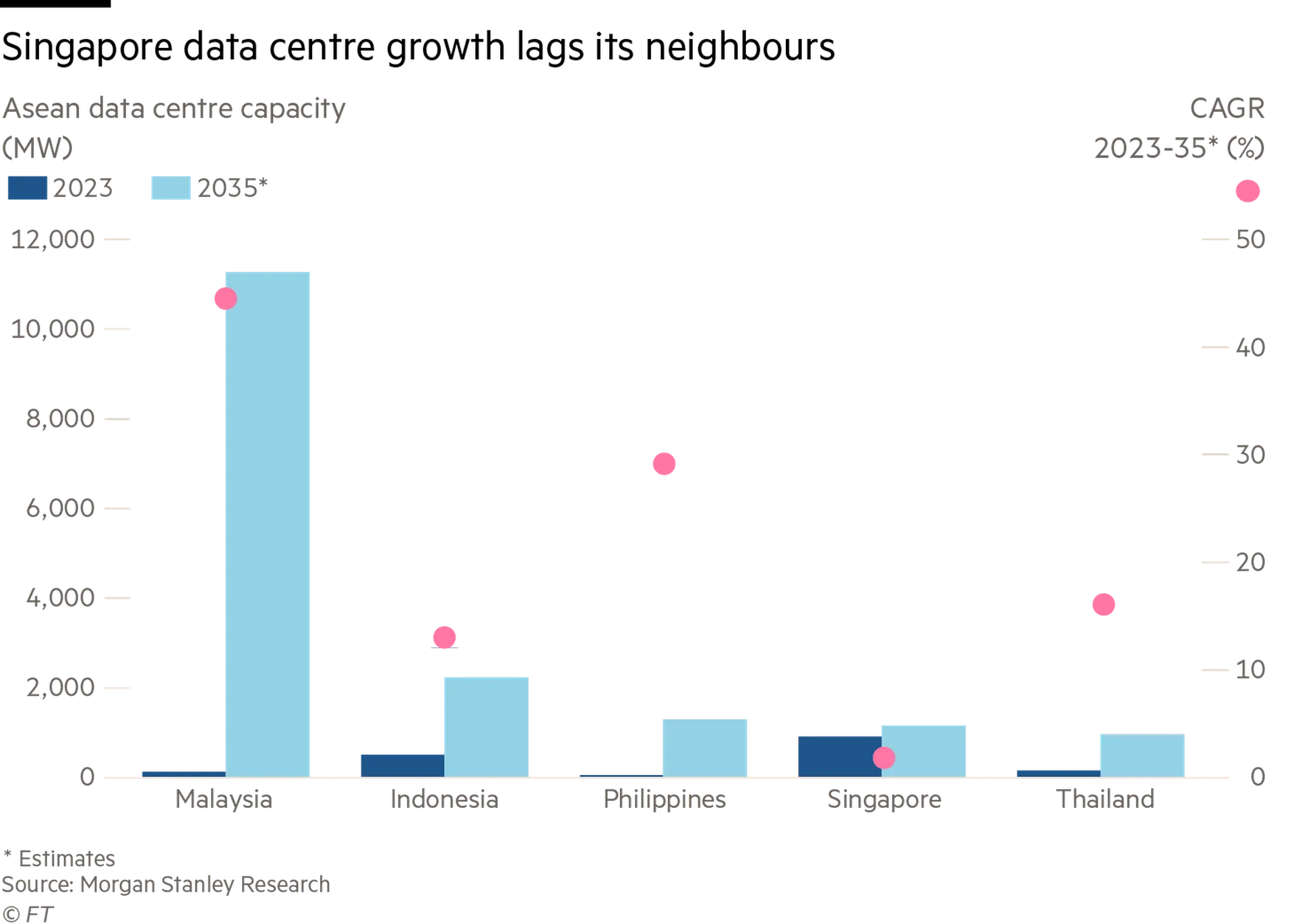尊敬的用户您好,这是来自FT中文网的温馨提示:如您对更多FT中文网的内容感兴趣,请在苹果应用商店或谷歌应用市场搜索“FT中文网”,下载FT中文网的官方应用。
Singaporeans are a competitive bunch. One of the must-know Singlish words for those living in the city-state is kiasu. The Chinese Hokkien term roughly means a fear of missing or losing out and often refers to someone trying to get ahead of others. “Fomo on steroids” is how one Singaporean friend describes it.
新加坡人是一群有竞争力的人。对于居住在这个城市国家的人来说,必须要知道的新加坡英语(Singlish)词汇之一就是“kiasu”(惊输,意为“怕输”)。这个闽南语词的大致意思是害怕错过或落后,通常指某人试图超越他人。一位新加坡朋友对此的形容是“加强版Fomo”(Fomo即Fear of missing out的缩写,意为“害怕错过”)。
One of the best places to see this in action is the queues at lunchtime around stalls of the city-state’s favourite hawker food markets. Another area to observe the kiasu mentality in the Asian financial centre is in business, such as foreign investment.
最能体现这一点的地方之一是新加坡最受欢迎的熟食市场在午餐时间排起的长队。另一个可以观察到这个亚洲金融中心的“怕输”心态的领域是商业,比如外国投资。
Singapore made a surprise announcement last month that it would free up more power for data centre expansion. The move came as the chief executives of Nvidia, Google, Microsoft and others have been swinging by neighbouring Malaysia — and other countries in south-east Asia — in recent months pledging billions in data centre investment.
新加坡上月意外宣布,将为数据中心扩张提供更多电力。最近几个月,英伟达(Nvidia)、谷歌(Google)、微软(Microsoft)等公司首席执行官纷纷访问邻国马来西亚及其他东南亚国家,承诺在数据中心投资上投入数十亿美元。
In Malaysia alone, the tech groups — three of the top four biggest companies by market capitalisation globally — have committed $8.5bn in new data centre, cloud and artificial intelligence investment in the past six months. Which is why more than one Malaysian government official joked that Singapore’s decision to court more data centres was a “typical Singapore kiasu response” to its neighbour’s progress.
仅在马来西亚,上述科技集团(全球四大市值最高公司中的三家)在过去6个月里已经承诺投资85亿美元用于新的数据中心、云计算和人工智能。这就是为什么不止一位马来西亚政府官员开玩笑说,新加坡决定争取更多的数据中心,是对邻国进展的“典型新加坡怕输反应”。
Of course there is some competition between Singapore and its neighbours, especially Malaysia from which it gained independence in 1965. But it is overly simplistic to dismiss Singapore’s move as kiasu-ness — even if there is an element of that at play. The city-state is already hyper connected and one of the biggest data centre markets in Asia — a trend that accelerated as Hong Kong became a less favoured destination for data centres and undersea cables. It is one of the top submarine cable hubs globally, with connections to 25 active subsea cables and more to come. None of that will change soon.
当然,新加坡与其邻国之间存在一些竞争,尤其是马来西亚——新加坡在1965年从马来西亚独立出来。但是,将新加坡的举动归咎于“怕输”,是过于简单化的观点——即使其中确实有这样的因素。这个城市国家的网络已经非常发达,并成为亚洲最大的数据中心市场之一——在香港作为数据中心和海底电缆目的地不如以往那么受青睐之后,这一趋势加速发展。它是全球顶级的海底电缆枢纽之一,与25条活跃的海底电缆相连,未来还将有更多的连接。这一切都不会很快改变。
The decision to increase data centre capacity last month was a surprise to many because the government imposed a more than three-year moratorium on new data centres between 2019 and 2022. The proliferation of the energy-guzzling facilities had been consuming a substantial amount of Singapore’s resources. That ban helped push data centre companies into nearby Johor, the Malaysian state just across the causeway, and to a certain extent Batam, a close-by Indonesian island.
上月决定增加数据中心容量的举措对许多人来说是个意外,因为新加坡政府在2019年至2022年间对新数据中心实施了超过三年的禁令。这些耗能设施的大量增加一直在消耗新加坡的资源。而该禁令促使数据中心公司转向附近的马来西亚州柔佛,以及在一定程度上转向附近的印尼岛屿巴淡岛。
The conundrum Singapore faces now — like many other countries — is that it grossly underestimated how demand for AI is going to expand the global market for data centres in coming years. The city-state has made little secret of the fact that it wants to be the AI hub for south-east Asia, if not the top in Asia.
新加坡现在面临的难题——就像许多其他国家一样——是它严重低估了未来几年人工智能的需求将如何扩大全球数据中心市场。这个城市国家毫不掩饰它希望成为东南亚的人工智能中心,甚至成为亚洲顶级中心。
That’s because being such a hub brings other economic benefits. For example, as part of Nvidia’s data centre investment in Malaysia, the company will partner with local conglomerate YTL Power to develop the country’s fastest supercomputers using Nvidia’s AI chips. Microsoft last month unveiled landmark AI infrastructure investments in Indonesia and Thailand.
这是因为,成为这样一个枢纽能带来其他经济利益。例如,作为英伟达在马来西亚数据中心投资的一部分,该公司将与当地的杨忠礼电力集团(YTL Power)合作,使用英伟达的人工智能芯片开发该国最快的超级计算机。微软上月在印尼和泰国揭幕了具有里程碑意义的人工智能基础设施投资。
Singapore realises it cannot ultimately compete with its neighbours for land and power. The key is how to complement it. The reason Johor is popular with global tech giants from ByteDance to Nvidia and Microsoft is because it is just a few kilometres away from hyperconnected Singapore.
新加坡意识到,它无法与邻国在土地和电力上进行最终竞争。关键在于如何相互补充。字节跳动(ByteDance)、英伟达和微软等全球科技巨头之所以青睐柔佛,是因为它距离网络发达的新加坡只有几公里。
“Both Johor and Singapore can benefit from the data centre boom. They complement each other,” says Rangnath Salgame, chair and chief executive of Princeton Digital Group, an Asian data centre company based in Singapore but expanding in Johor. It is a “symbiotic relationship”, he adds.
“柔佛和新加坡都可以从数据中心的繁荣中受益。它们互相补充,”普林斯顿数字集团(Princeton Digital Group)的主席兼首席执行官兰格纳特•萨尔加姆(Rangnath Salgame)说道。该公司是一家总部位于新加坡但在柔佛扩张的亚洲数据中心公司。他补充说,这是一种“共生关系”。
And as more and more companies diversify supply chains away from China that puts Singapore in pole position. One way it can benefit is by promoting a Singapore + one strategy, whereby companies establish a headquarters in the country to leverage its international business environment, free trade agreements and access to professional talent, but then have their manufacturing — or data centre — facilities in places such as Johor.
随着越来越多的公司将供应链从中国分散出去,新加坡占据了领先地位。一种受益的方式是推动“新加坡+1”战略,即公司在新加坡设立总部,利用其国际商业环境、自由贸易协定和专业人才,然后将制造业或数据中心设施设在柔佛等地。
This is already a long-term trend. Singapore was the top recipient of inward foreign direct investment flows in south-east Asia between 2013 and 2022, according to the latest data published by the bloc. In 2022, Singapore attracted $141bn of FDI, accounting for more than half of the region’s total. So should Singapore really be kiasu?
这已经是一个长期趋势。根据东盟最新发布的数据,新加坡在2013年至2022年间成为东南亚地区吸引外国直接投资流入最多的国家。2022年,新加坡吸引了1410亿美元的外国直接投资,占该地区总额的一半以上。那么,新加坡真的应该“怕输”吗?

